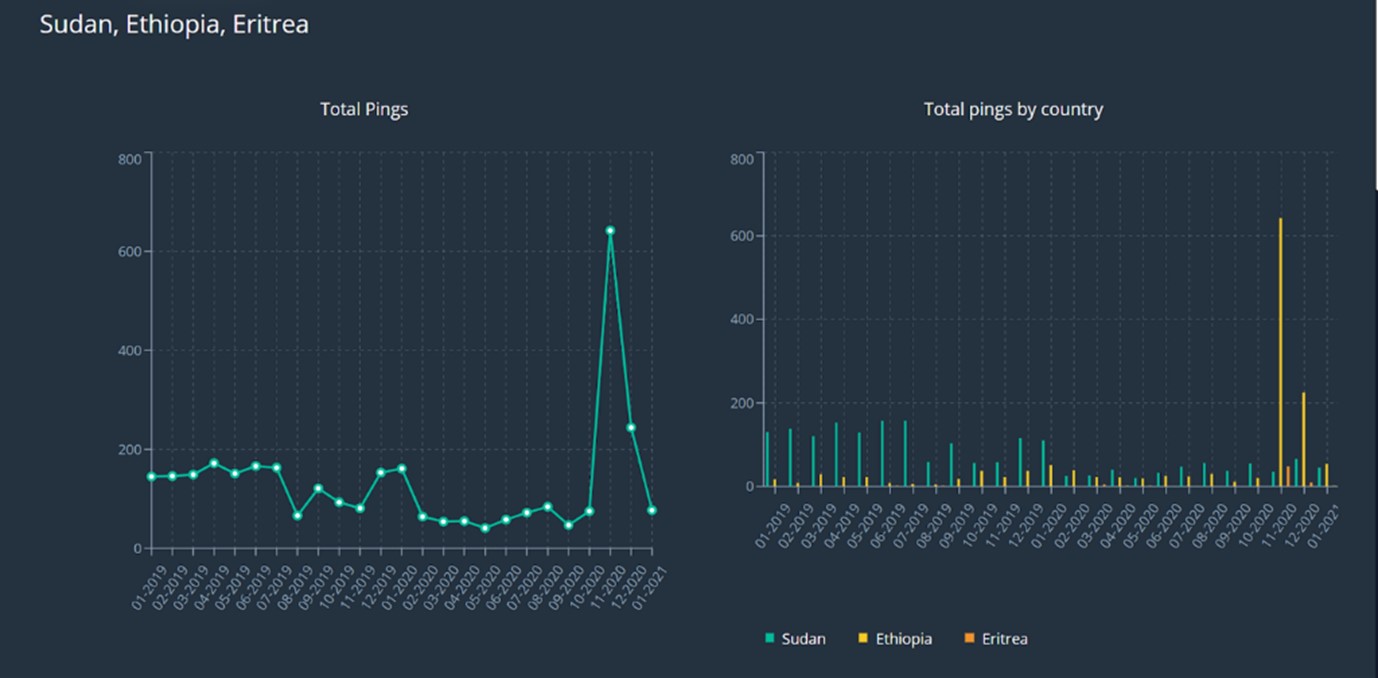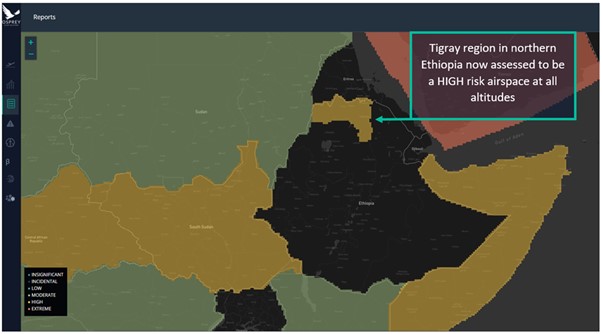The latest conflict emanating from the Tigray Region in Ethiopia was initiated when the Tigray People’s Liberation Front (TPLF) launched a raid on a military base in the Tigray capital, Mekele, on 4 November. Over subsequent weeks, escalating armed clashes between the TPLF and Ethiopian — and Eritrean — government forces, involving surface-to-air missiles and targeted attacks on airports in the region, posed a significant threat to civil aviation.
Osprey’s open-source data gathering, analytics and analysis capability promptly identified this risk to aviation via an increase in conflict zone activity in the region, and issued a series of alerts containing detailed, up-to-date information and advice, even after NOTAMs for the affected regions were lifted.
Since early November, the Ethiopian military has been engaged in an offensive involving near-daily air and artillery strikes against the Tigray People’s Liberation Front (TPLF) violent non-state actor (VNSA) group in the north of the country and along the borders with Eritrea and Sudan. From early November through mid-December, the airspace over Ethiopia’s Tigray Region was effectively closed by the government to civilian air traffic due to the armed conflict. Ethiopian military operations in Tigray have reportedly resulted in government forces retaking control of main urban centres in the region from the TPLF over the past two months.
Potential indirect-fire attacks via rockets, mortars or artillery against airports and air bases within the north of the country posed an emerging threat to civil aviation.
According to media reports quoting a United Nations (UN) internal security report, the TPLF seized “heavy weapons” from several of the Ethiopian National Defence Force (ENDF) Northern Command’s military depots in early November. Osprey Flight Solutions assessed that the TPLF in northern Ethiopia, and ENDF units, which the TPLF claimed had defected, would have a variety of rockets, mortars and artillery pieces within their inventory, as well as a range of light weapons. As such, potential indirect-fire attacks via rockets, mortars or artillery against airports and air bases within the north of the country posed an emerging threat to civil aviation. In addition, the potential use of multiple rocket launcher systems (MRLS), guided-rocket artillery and/or short-range ballistic missiles (SRBMs) posed an all-altitude hazard to civil aviation over Tigray. Potential indirect-fire attacks via rockets, mortars or artillery against airports and air bases within the north of the country posed an emerging threat to civil aviation.
During November, the TPLF conducted several MRLS, guided-rocket artillery and/or SRBM strikes against targets in Ethiopia’s Amhara Region, located well south of Tigray Region, including the airports in Bahir Dar (HABD/BKR) and Gondar (HAGN/GDQ). On three occasions in November, the TPLF reportedly conducted a series of MRLS and/or guided-rocket artillery strikes from northern Ethiopia into Eritrea against targets in the Eritrean capital, including Asmara International Airport (HHAS/ASM).

Osprey Flight Solutions issued an alert on 5 November following the announcement by Prime Minister Abiy Ahmed that the TPLF had conducted attacks against the ENDF in Tigray Region. As shown by the Osprey:Explore charts above, prior to November, activity in Ethiopia, Eritrea and Sudan had remained relatively consistent during the preceding months. In addition, in December, the level of activity declined from its peak in November, albeit not to the level witnessed prior to the conflict emerging. This decline followed a claim by the Ethiopian prime minister in late November that the military operation in Tigray Region was “complete”. Consequently, airspace restrictions related to FIR Addis Ababa (HAAA) and FIR Asmara (HHAA) were lifted. Although activity further declined in January, risks to commercial and military aviation persist over the region, given ongoing military operations by the ENDF against the TPLF and reports that the TPLF remains in control of military-grade weaponry.
Osprey Analysis: Aviation Impacts
In response to the conflict activity, on 4 November, the government announced a six-month state of emergency in the Tigray Region, and the Ethiopian Civil Aviation Authority (ECAA) issued NOTAMs for northern FIR Addis Ababa (HAAA) closing several waypoints and ATS routes, effectively closing the airspace over Tigray Region. In addition, the Tigrayan authorities stated that the airspace over the region was “closed” and flights were cancelled to the airports in Gondar, Mekele (HAMK/MQX), Shire (HASR/SHC) and Axum (HAAX/AXU). Neighbouring Sudan also issued two NOTAMs in response to the conflict, effective from 3 December, restricting flights transiting between Sudanese (FIR Khartoum (HSSS)) and Ethiopian (FIR Addis Ababa (HAAA)) airspace to specific waypoints and ATS routes. However, the NOTAMs were cancelled on 24 December.
While the ECAA issued three NOTAMs, which effectively closed the airspace over the Tigray Region, the airways that remained open through the airspace allowed operators to fly in proximity to the reported conflict. For example, the UL432 airway remained open and all air traffic between FIR Addis Ababa (HAAA) and FIR Asmara (HHAA) was routed through the BOPSA waypoint, located over the Ethiopia/Eritrea border. Moreover, the NOTAMs issued by the ECAA did not state why the restrictions had been imposed, limiting operators‘ abilities to fully assess the risk involved in continuing to operate in the region. Further, given the mobility of the weapons said to have been in the possession of the TPLF at various stages during the conflict, the restrictions enacted by the ECAA may not have been sufficient to mitigate the risk of direct and indirect fire; for example, through the use of conventional surface-to-air missiles (SAMs) and man-portable air defence systems (MANPADS).
Following almost six weeks of conflict, on 14 December, the ECAA announced that the portion of FIR Addis Ababa (HAAA) airspace over the northern Tigray Region had been fully reopened and airports in the area would resume civilian flight operations. Additionally, following the removal of airspace restrictions, Ethiopian Airlines announced the resumption of flights to airports in Tigray and Amhara regions, including Mekele, Bahir Dar and Gondar airports, the latter of which were suspended following the attacks targeting the installations on 13-14 November.
In an alert issued on 14 December, Osprey Flight Solutions emphasised the continued risk to aviation posed by the ongoing conflict.
In an alert issued on 14 December, Osprey Flight Solutions emphasised the continued risk to aviation posed by the ongoing conflict. The alert listed conventional SAM sites in main urban centres in the Tigray region — initially identified and reported by Osprey in November — and highlighted that, while the ENDF reported that it had assumed control of these areas, contradictory claims by the TPLF, as well as communication issues in the region, made such information difficult to verify and the residual risks to aviation difficult to evaluate. In addition, the potential use of MRLS, guided-rocket artillery weapons and SRBMs persisted as an all-altitude hazard to civil aviation over Tigray.
Despite the removal of airspace restrictions, we assessed the Tigray Region to be a high-risk airspace at all altitudes, and airports in Ethiopia to be high-risk operating environments. We also emphasised that the situation in the region was, and continues to be, far from resolved and that further flare-ups are likely in these and surrounding areas. In particular, we note the continuing risk posed to neighbouring airspaces as the conflict breaches the Ethiopian borders with Eritrea and Sudan.

Osprey Alerts
- On 5 November, Osprey issued a critical alert following the launch of the Ethiopian military offensive against the TPLF in Tigray Region, and airspace and airport closures were reported.
- On 7 November, Osprey issued a critical alert following the launch of the military offensive and noted that airstrikes by the ENDF had occurred near both Mekele and Axum and military drone operations were reported over Adigrat.
- On 8 November, Osprey issued a critical alert highlighting the ongoing military offensive by the ENDF against the TPLF in Tigray Region. Osprey also reported that the TPLF had claimed to have shot down an Ethiopian military combat aircraft near Mekele on 8 November.
- On 11 November, Osprey issued a critical alert highlighting that the military offensive against the TPLF in Tigray Region was ongoing.
- On 14 November, Osprey issued a critical alert after attacks by the TPLF targeted Gondar and Bahir Dar airports in Amhara Region.
- On 14 November, Osprey issued an additional critical alert after the TPLF reportedly conducted rocket attacks targeting the Eritrean capital, including against Asmara International Airport, and the city of Massawa.
- On 15 November, Osprey issued a critical alert when the US Department of State issued a condemnation of the TPLF attacks on Eritrea.
- On 20 November, Osprey issued a critical alert after the TPLF reportedly conducted a rocket attack against unspecified targets in Bahir Dar.
- On 23 November, Osprey issued a critical alert after the TPLF reportedly conducted a further rocket attack against unspecified targets in Bahir Dar.
- On 27 November, Osprey issued a critical alert after the TPLF reportedly conducted a rocket attack from northern Ethiopia into Eritrea against unspecified targets in the capital Asmara and the city of Dekhemhare.
- On 28 November, Osprey issued a critical alert after the Ethiopian Prime Minister stated that the ENDF had entered the Tigrayan regional capital of Mekele and the military stated that the ENDF was in full control. In addition, the ENDF has claimed to be in control of a number of main urban centres in Tigray Region.
- On 28 November, Osprey issued a second critical alert after the TPLF reportedly conducted a rocket attack from northern Ethiopia against the Eritrean capital, Asmara.
- On 30 November, Osprey issued a critical alert when the TPLF claimed to have shot down an ENDF MiG-23 combat aircraft over the northern Tigray Region near Abiy Adi.
- On 7 December, Osprey issued a critical alert after reports emerged the previous day indicating that the TPLF had shot down an ENDF combat jet over the north of the country near Shire.
- On 14 December, Osprey issued a critical alert as the Ethiopian Civil Aviation Authority announced that the portion of FIR Addis Ababa (HAAA) airspace over the northern Tigray Region had been fully reopened and airports in the area would resume civilian flight operations. However, Osprey highlighted that the armed conflict was ongoing and warned that airspace restrictions could be reimposed.







